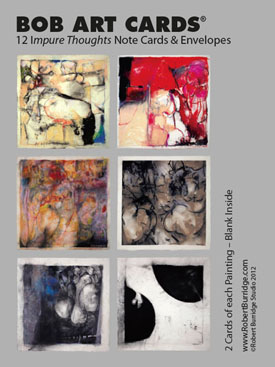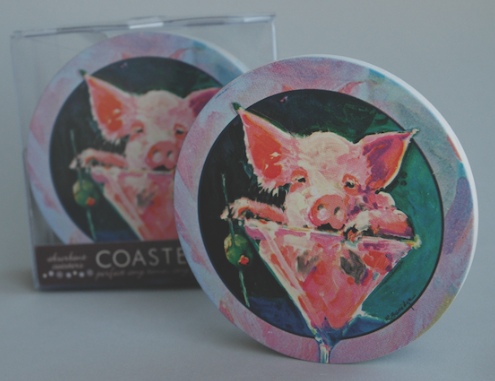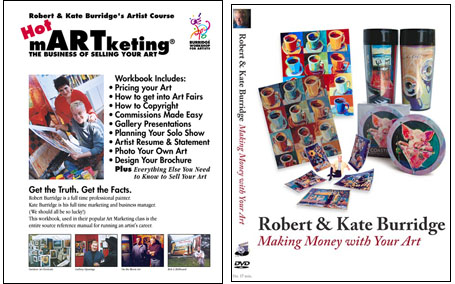Linda Waldon interviews Kate Burridge, Art Marketing Director
Part Three: The State of Art Marketing According to Kate

This is the final installment of my interview with art marketing director, Kate Burridge. You can see part one of the interview here, and part two here. Kate is an author, lecturer and artist advisor, and is on the board of the ISAP (International Society of Acrylic Painters) as their marketing director. Kate co-teaches an eight-week course (which I attended) called “Art Marketing: The Business of Selling Your Art” and produces the art newsletter, The ArtsyFartsy News.
In Part Three of the interview Kate gets into the state of the art market today, what is happening with galleries, and how artists can still find their art collectors even during this economic downturn. At the time of this interview, Kate's husband, Robert Burridge, was a week away from his art opening, Impure Thoughts...Large Installation Drawings in Chalk, Ash, Pastels & Powders at the San Luis Obispo Museum of Art. Kate refers to the preparation for this exhibition.
Linda: It really seems that you have to be creative nowadays to get your work in front of a gallery. Because many galleries don't accept submissions, it's almost impossible to walk in and pull out your portfolio.
Kate: Yes, it is. Since the market has been so odd lately, it's going to continue to be closed off a bit. It's one of two things: either the gallery may not know what they're going to be doing and so they're not going to want to get any new artists in there because they could be on the verge of closing, or they already have their stable of artists they're very happy with, and with you coming in, it might dilute the sales of somebody else so they're not going to take you.
But, if you go in on another artist's referral, that can sometimes work out very well.

A lot of the galleries we were showing in closed and I pulled work out of some that I thought weren't going to be open for too much longer, so we got ourselves down to one or two galleries. This past week a good friend of ours who moved to Santa Fe with the dream to open a gallery called me and said, "Can we have work?" We know them. They've been to our house. We trust them, so I said absolutely! So now we have a gallery in Santa Fe, and a gallery in Key West because Bob did a workshop there. At the time, the owner where we did the workshop said you might as well have a show, and it did so well that they said let's just keep you. And, another gallery owner called on Friday and told us he's reopening his gallery!
Linda: Is that an indication that maybe things are starting to move again?
Kate: I'm hoping. I'm a firm believer in not burning bridges, because you don't know when you might need to use that bridge again.
Linda: Very good advice for everything—any kind of business.
Kate: And you know, with art marketing, you're not in that different of a business. It might have different players and different ways of doing things, but marketing is marketing. Getting the word out about who you are and what you're doing.
Linda: What's the economic climate for artists right now?
Kate: I think it's getting better. It's by no means wonderful. I'll give a little background about when the art market crashed right around the year 2008. When the stock market took that major dive, it wiped out the entire tier of people who would purchase art from newly emerging, up and coming artists whose work was not very expensive. All the venture capitalists who had new money were buying $5,000 to $10,000 paintings, which was right where our market was. Overnight that market disappeared. Bob was not well enough known for the buyers who were in the higher echelon to purchase anything because they just didn't know him. Those high-end buyers were putting their money into the Rauschenbergs, Lichtensteins, and works like that. That's out of the league of almost everybody, and those buyers are not our buyers.
When it comes to the middle class coming back and buying art I'd say not for a while—there just isn't that much money out there. But for higher end people, sure. Back in the day, at the San Francisco gallery, where we were selling a lot of work, the gallery owner would tell us we had all these students looking at our work. She was thinking students—not so good. I was thinking students—future buyers. I can say without any hesitation at all, Bob's students are the main buyer base for large and small works, anything!
Linda: Your art workshop students? I can definitely see that. Those are people with discretionary cash and time and interest in art.
Kate: Yes, they have to have money for the workshop and airfare. So, again, that's another bridge you never want to burn.
When the art market started vanishing, that's when we started going real small. So, Bob will have 12x12 paintings on a wood panel or canvas which brought the price point down. But still it was a valuable little canvas. We kept up doing smaller things, just more of them.
Linda: I can hear an artist saying, "But I love painting on large canvases." What I think you're saying is if you really are interested in marketing your art you have to provide some variety in size and pricing.
Kate: Yes. It's like there's something for everyone. It's a funny thing because we teach about when putting on your own exhibition it's visually beautiful to walk into an exhibit hall and see all the work the same size. But, smarter is having all different sizes for all different price points. When you go to the SLO museum show you're going to see just about all the same size! Is it important for Bob to sell for the museum show? No.
Linda: From what I understand about that particular show, it's much more of an artistic expression for Bob.

Kate: Exactly. We do have three sizes though: 7x7 foot giant works on paper, and 39x39 inches, and then we have 9x12 inch sketches on paper. There is something for everyone. It's going to be stapled to the wall.
Linda: I love it. It's like an artist's dream.
Kate: We're pretty happy about it. I don't know if I answered your question.
Linda: I think so, I was really asking about what are some creative ways that an artist nowadays can get in front of a gallery owner.
Kate: I'm still going to say art festivals are also a really good way to go.
Linda: Are those still popular and well attended?
Kate: Yes, they are. The good ones. You have to be really careful in choosing which ones you go to—we still do the Sausalito festival every year we can. This is its sixtieth year.
Linda: Changing the topic, you talk about copyright as a vastly misunderstood subject. What do artists need to understand about copyright law?
Kate: I'd say they need to educate themselves. There's a very cool website plagerismtoday.com. The person who created the website is not an attorney, but he's somebody who really cares about it. The content is amazing.
Artists need to know that if they borrow from another artist's work or incorporate that artist's work into their work, even to the point of copying pictures, they're infringing. There is no set percentage they can follow – if I change it 35% for example – there's no such thing as fair use. If you are copying, you're copying.
Linda: Are you talking about content or artistic interpretation?
Kate: Yes, artistic interpretation, concept, and execution. Mainly content. Here's how interesting it gets. There was somebody from Cheap Joes, their staff, who emailed me, and told me she had a situation. Her question was: if an artist is doing a step by step painting lesson for a magazine, for example, Artist Magazine or American Artist, who owns the finished painting? It's that sort of thing. Of course, the artist who did it, owns it. However, they're really not able to use it for anything because the design of it, the content was created beforehand. It's the same thing with work done in a workshop under an art teacher, who in some cases, even guides their hand or actually paints on their painting. It's little things like that that we need to consider as practice pieces or studio sketches, but nothing that is actually a piece of artwork for sale or show.
Linda: It sounds nuanced.
Kate: Totally. A lot of it is up to interpretation.
Linda: If you accept a commission for art, and you create the piece of art for the client...
Kate: It's not a work for hire—they're not doing a W2 form or paying your taxes on it—you're still the private contractor.
Linda: So you retain the copyright.
Kate: Yes. Unless you sell, assign, or give away your copyright in writing.
Linda: So, in general terms, a piece of art that you create and paint, you always maintain the copyright?

Kate: Always. If you're ever asked to sign it over for any reason, always ask why. In some cases they don't know. I'll see these odd calls for entries, usually for poster images, and they'll say "All entries become the property of so-and-so." That makes no sense to me at all.
Linda: It just means they just don't want to return it to the artist.
Kate: Exactly. But, by law, they're saying that they now own the copyright. Do not enter those! The good companies that do licensing all the time, the first thing it states on the contract is 'The artist owns the copyright.' Or they will say if the artist cannot prove that the material is their property, then we can't go forward with it. Be very, very careful with it.
Artists own their own stuff, they don't have to ask permission to publish their own things even if it has been sold because the person who purchased it just owns the piece, they don't own the copyright or intellectual property.
Linda: Bearing in mind that self-promotion is difficult for most people, in any walk of life, but especially artists, what do you think is a way artists can get more comfortable with promoting their work?
Kate: Just by doing it, you get more comfortable the more you do it. Sometimes Facebook can be a wonderful thing because you're anonymously promoting yourself.
The way we use Facebook we don't post personal stuff on it, you know, like what we ate for dinner. It's always about having a show. We use it as a means to an end. People need to get over the thought that other people aren't interested. They are. They won't listen if they're not interested.
Linda: You taught me in the art marketing workshop that art buyers love to know something about the artist, as well as falling in love with the piece.
Kate: Absolutely.
Linda: The more the artist can almost force themselves to be out there...
Kate: You know, it's a behavioral thing, and behavior can be changed. I think it's all those parents, teachers, and nuns who told you not to brag about yourself. You're not bragging, you're disseminating information!
Linda: Have self-confidence. Being confident about your collection I'm sure really helps.
Kate: Um hum. That goes back to that first thing we were talking about of having the focus of knowing what to say.
Linda: How important is it for artists to inventory their work? What happens if they don't?
Kate: Oh my gosh. If they don't they're out of control. Especially if they have it for sale on the website and what if somebody wants to buy it but it's already been sold, but they didn't keep track.
Linda: Or they don't know where it is physically located. Could they start out using a spreadsheet to track inventory, or are you familiar with Art Tracker?
Kate: I use Bento. It's a FileMaker program. It costs $49.
Linda: So, just to pull this all together, I wanted to ask you what are your plans for the future? Where do you see yourself in five years, ten years time?
Kate: Cutting down on the workshops, a lot. We're starting that process now. Bob is out of town a good thirty weeks out of the year. It gets really old, especially with the airline travel. What we're doing is we're lining up our ducks to know what workshops to keep and then have more workshops here at his studio, and then be able to work more on galleries. Hopefully, do more web-based stuff, like web seminars. Unfortunately, we live in a spot where we don't have high-speed Internet, and it's just killing us. We're thinking, where do we go to do these web seminars?
Linda: A hotel.
Kate: Exactly. We're going to run some workshops out of a hotel room.
Linda: So take advantage of web conferencing to teach seminars.
Kate: Yes. And maintain and expand our product line for artists, because we have color wheels and studio charts right now, and also books for sale. I've been working on a workbook to make it into an eBook and finding the right type of commerce machine for that. It's all good. We'd like to have both of us be around more.
Linda: Thank you. I learned a lot.
Kate: You're welcome. This was fun.

Our monthly radio show: Designing a Creative Life
| 






